Preparation and Performance of Al2O3/Ti(C,N)-Added ZrO2 Whisker and NanoCoated CaF2@Al(OH)3 Powder
Abstract
:1. Introduction
2. Materials and Methods
2.1. Fabrication of Nano Coated CaF2@Al(OH)3 Powder
2.2. Fabrication of Al2O3/Ti(C,N)/ZrO2/CaF2@Al(OH)3 Ceramic Material
2.3. Performance Testing of the Ceramic Material
3. Results and Discussion
3.1. XRD Phase Composition Diagram of the Ceramic Material
3.2. Influence of ZrO2 Whisker Addition on Al2O3/Ti(C,N) Ceramic Material
3.3. Influence of Nano Coated CaF2@Al(OH)3 Powder on Al2O3/Ti(C,N) Ceramic Material
3.4. Mechanism Analysis of Co-Modification of Micron ZrO2 Whisker and Nano Coated CaF2@Al(OH)3 Powder
4. Conclusions
- (1).
- The ZrO2 whisker with 0, 3 vol%, 6 vol% and 9 vol% were added to the Al2O3/Ti(C,N) ceramic material. The result revealed that when the additive amount of the ZrO2 whisker was 6 vol%, the hardness, the flexural strength and the fracture toughness values were 19.1 GPa, 584 MPa and 6.61 MPa·m1/2, respectively. Whisker toughening and the phase transition toughening of the ZrO2 enhanced the mechanical properties of the ceramic material.
- (2).
- The addition of nano coated CaF2@Al(OH)3 powder also had a significant influence on the mechanical properties of the ceramic material. The intragranular structures played a good role in enhancing the mechanical properties of the ceramic material. When the nano coated CaF2@Al(OH)3 powder addition was 10 vol%, the mechanical properties of the ceramic material was the best. The hardness, flexural strength and fracture toughness values of the prepared ceramic material were 18.58 GPa, 471 MPa and 6.50 MPa·m1/2, respectively.
- (3).
- The ZrO2 whisker of 6 vol% and nano coated CaF2@Al(OH)3 powder of 10 vol% were simultaneously added to the Al2O3/Ti(C,N) ceramic material. The hardness of the Al2O3/Ti(C,N)/ZrO2/CaF2@Al(OH)3 ceramic material was 16.72 GPa, the flexural strength was 520 MPa, and the fracture toughness reached 7.16 MPa·m1/2. The fracture toughness of the Al2O3/Ti(C,N)/ZrO2/CaF2@Al(OH)3 self-lubricating ceramic tool material was better than the added ZrO2 whisker or added nano coated CaF2@Al(OH)3 powder of the Al2O3/Ti(C,N) ceramic material, separately. The formation of intragranular structure, whisker toughening and phase transition of ZrO2 were the main mechanisms.
Author Contributions
Funding
Conflicts of Interest
References
- Liu, X.; Zou, B.; Xing, H.; Huang, C. The preparation of ZrO2-Al2O3 composite ceramic by SLA-3D printing and sintering processing. J. Ceram. Int. 2020, 46, 937–944. [Google Scholar] [CrossRef]
- Chen, Q.; Zou, B.; Lai, Q.; Wang, Y.; Xue, R.; Xing, H.; Fu, X.; Huang, C.; Yao, P. A study on biosafety of HAP ceramic prepared by SLA-3D printing technology directly. J. Mech. Behav. Biomed. Mater. 2019, 98, 327–335. [Google Scholar] [CrossRef]
- Wang, Y.; Zou, B.; Wang, J.; Wu, Y.; Huang, C. Effect of the progressive tool wear on surface topography and chip formation in micro-milling of Ti-6Al-4V using Ti(C7N3)-based cermet micro-mill. J. Tribol. Int. 2020, 141, 105900. [Google Scholar] [CrossRef]
- Ouyang, Y.; Bai, L.; Sun, Z.; Ding, F.; Yuan, F. A new strategy for dense Al2O3 ceramics by spherical powders prepared via thermal plasma. J. Ceram. Int. 2018, 45, 2012–2019. [Google Scholar] [CrossRef]
- Cao, W.; Mao, X.; Yuan, Y.; Li, L.; Zhao, L.; Li, J. Sintering kinetics of disperse ultrafine equiaxed α-Al2O3 nanopowders. J. Eur. Ceram. Soc. 2017, 37, 4005–4013. [Google Scholar] [CrossRef]
- Wang, X.; Zhao, J.; Cui, E.; Song, S.; Liu, H.; Song, W. Microstructure, mechanical properties and toughening mechanisms of graphene reinforced Al2O3-WC-TiC composite ceramic tool material. J. Ceram. Int. 2019, 45, 10321–10329. [Google Scholar] [CrossRef]
- Xing, Y.; Liu, L.; Wu, Z.; Wang, X.; Huang, P.; Tang, L. Fabrication and characterization of micro-channels on Al2O3/TiC ceramic produced by nanosecond laser. J. Ceram. Int. 2018, 44, 23035–23044. [Google Scholar] [CrossRef]
- Xing, H.; Zou, B.; Lai, Q.; Huang, C.; Chen, Q.; Fu, X.; Shi, Z. Preparation and characterization of UV curable Al2O3 suspensions applying for stereolithography 3D printing ceramic microcomponent. Powder Technol. 2018, 338, 153–161. [Google Scholar] [CrossRef]
- Fang, Y.; Chen, N.; Du, G.; Zhang, M.; Zhao, X.; Wu, J. Effect of Y2O3-stabilized ZrO2 whiskers on the microstructure, mechanical and wear resistance properties of Al2O3 based ceramic composites. J. Ceram. Int. 2019, 45, 16504–16511. [Google Scholar] [CrossRef]
- Cheng, Y.; Zhang, Y.; Wan, T.; Yin, Z.; Wang, J. Mechanical properties and toughening mechanisms of graphene platelets reinforced Al2O3/TiC composite ceramic tool materials by microwave sintering. Mater. Sci. Eng. A 2017, 680, 190–196. [Google Scholar] [CrossRef]
- Li, Z.; Zhao, J.; Sun, J.; Gong, F.; Ni, X. Reinforcement of Al2O3/TiC ceramic tool material by multi-layer grapheme. J. Ceram. Int. 2017, 43, 11421–11427. [Google Scholar] [CrossRef]
- Stolin, A.M.; Bazhin, P.M.; Konstantinov, A.S.; Chizhikov, A.P.; Kostitsyna, E.V.; Bychkova, M.Y. Synthesis and characterization of Al2O3-ZrO2-based eutectic ceramic powder material dispersion-hardened with ZrB2 and WB particles prepared by SHS. J. Ceram. Int. 2018, 44, 13815–13819. [Google Scholar] [CrossRef]
- Dos Santos, C.; Cossu, C.M.F.A.; Alves, M.F.R.P.; Campos, L.Q.B.; Magnago, R.O.; Strecker, K. Al2O3/Y-TZP ceramic composite with unidirectional functional gradient. J. Int. J. Refract. Met. Hard. Mater. 2018, 75, 147–152. [Google Scholar] [CrossRef]
- Chen, Y.; Lu, Z.; Miao, K.; Cao, J.; Li, D. Effect of chemical vapour infiltration technique on the gradient microstructure and high-temperature strength of gel-cast Al2O3-based ceramic moulds. J. Ceram. Int. 2018, 44, 18617–18624. [Google Scholar] [CrossRef]
- Funari, M.F.; Greco, F.; Lonetti, P. A moving interface finite element formulation for layered structures. Compos. Part B 2016, 96, 325–337. [Google Scholar] [CrossRef]
- Yang, L.; Shen, P.; Guo, R.; Li, Y.; Jiang, Q. A novel strategy for fabricating biomimetic gradient metal-ceramic composites by dynamic freeze casting and pressure infiltration. J. Scr. Mater. 2019, 167, 101–104. [Google Scholar] [CrossRef]
- Katsui, H.; Goto, T. Coatings on ceramic powders by rotary chemical vapor deposition and sintering of the coated powders. J. Ceram. Soc. Jpn. 2018, 126, 413–420. [Google Scholar] [CrossRef] [Green Version]
- Dang, X.; Wei, M.; Fan, B.; Guan, K.; Zhang, R.; Long, W.; Zhang, H. Effects of in situ Synthesized Mullite Whisker on Mechanical Properties of Al2O3-SiC Composite by Microwave Sintering. J. Mater. Res. Express 2017, 4, 413–420. [Google Scholar] [CrossRef]
- Lv, X.; Ye, F.; Cheng, L.; Fan, S.; Liu, Y. Fabrication of SiC whisker-reinforced SiC ceramic matrix composites based on 3D printing and chemical vapor infiltration technology. J. Eur. Ceram. Soc. 2019, 39, 3380–3386. [Google Scholar] [CrossRef]
- Pakseresht, A.H.; Saremi, M.; Omidvar, H.; Alizadeh, M. Micro-structural study and wear resistance of thermal barrier coating reinforced by alumina whisker. J. Surf. Coat. Technol. 2019, 366, 338–348. [Google Scholar] [CrossRef]
- Wang, W.; Wei, C.; Liu, Z.; Li, S.; Wang, P.; Wen, G. Mechanical properties of laminated HfB2-SiC/SiCw material modified with silicon carbide whisker layer. J. Ceram. Int. 2019, 45, 21242–21248. [Google Scholar] [CrossRef]
- Tsujimoto, A.; Barkmeier, W.W.; Takamizawa, T.; Latta, M.A.; Miyazaki, M. Mechanical properties, volumetric shrinkage and depth of cure of short fiber-reinforced resin composite. Dent. Mater. J. 2016, 35, 418–424. [Google Scholar] [CrossRef] [PubMed] [Green Version]
- Zhu, W.; Liu, Y.; Guan, K.; Peng, C.; Wu, J. Preparation of ZrO2 fiber modified Al2O3 membrane supports with enhanced strength and permeability. J. Eur. Ceram. Soc. 2018, 39, 1712–1716. [Google Scholar] [CrossRef]
- Zu, Y.; Sha, J.; Li, J.; Zhang, Z.; Wang, S.; Lv, Z.; Dai, J. Effect of multi-walled carbon nanotubes on microstructure and fracture properties of carbon fiber-reinforced ZrB2-based ceramic composite. J. Ceram. Int. 2017, 43, 7454–7460. [Google Scholar] [CrossRef]
- Zhai, S.; Liu, J.; Wang, J. Microstructure of the directionally solidified ternary eutectic ceramic Al2O3/MgAl2O4/ZrO2. J. Ceram. Int. 2016, 42, 8079–8084. [Google Scholar] [CrossRef]
- Zhu, S.; Cheng, J.; Qiao, Z.; Yang, J. High temperature solid-lubricating materials: A review. J. Tribol. Int. 2018, 133, 206–233. [Google Scholar] [CrossRef]
- Zheng, Y.; Yu, W.; Yu, Y.; Su, X.; Yang, P. Fracture morphology and toughening mechanism of Al2O3/ZrO2 eutectic ceramic prepared by the combustion synthesis under ultra-high temperature. J. Int. J. Refract. Met. Hard. Mater. 2019, 81, 21–26. [Google Scholar] [CrossRef]
- Eckner, R.; Krampf, M.; Segel, C.; Krüger, L. Strength and Fracture Behavior of a Particle-Reinforced Transformation-Toughened Trip Steel/ZrO2 Composite. Mech. Compos. Mater 2016, 51, 707–720. [Google Scholar] [CrossRef]
- Verma, V.; Kumar, B.V.M. Synthesis, Microstructure and Mechanical Properties of Al2O3/ZrO2/CeO2 Composites with Addition of Nickel and Titania Processed by Conventional Sintering. J. Mater. Today Proc. 2017, 4, 3062–3071. [Google Scholar] [CrossRef]
- Yu, W.; Zheng, Y.; Pan, J.; Yu, Y. Phase evolution and microstructure analysis of Al2O3-ZrO2 (Y2O3) eutectic powders with ultra-fine nanostructure. J. Ceram. Int. 2019, 45, 23423–23430. [Google Scholar] [CrossRef]
- Wu, G.; Xu, C.; Xiao, G.; Yi, M.; Chen, Z. Structure design of Al2O3/TiC/CaF2 multicomponent gradient self-lubricating ceramic composite and its tribological behaviors. J. Ceram. Int. 2018, 44, 5550–5563. [Google Scholar] [CrossRef]
- Wu, G.; Xu, C.; Xiao, G.; Yi, M.; Chen, Z.; Chen, H. An advanced self-lubricating ceramic composite with the addition of core-shell structured h-BN@Ni powders. J. Int. J. Refract. Met. Hard. Mater. 2018, 72, 276–285. [Google Scholar] [CrossRef]
- Chen, H.; Xu, C.; Xiao, G.; Chen, Z.; Ma, J.; Wu, G. Synthesis of (h-BN)/SiO2 core-shell powder for improved self-lubricating ceramic composites. J. Ceram. Int. 2016, 42, 5504–5511. [Google Scholar] [CrossRef]
- Farzampour, A. Temperature and humidity effects on behavior of grouts. Adv. Concr. Constr. 2017, 5, 659–669. [Google Scholar] [CrossRef]
- Mansouri, I.; Shahheidari, F.S.; Hashemi, S.M.A.; Farzampour, A. Investigation of steel fiber effects on concrete abrasion resistance. Adv. Concr. Constr. 2020, 9, 367–374. [Google Scholar]
- Cui, E.; Zhao, J.; Wang, X. Effects of nano-ZrO2 content on microstructure and mechanical properties of GNPs/nano-ZrO2 reinforced Al2O3/Ti(C,N) composite ceramics. J. Eur. Ceram. Soc. 2020, 40, 1532–1538. [Google Scholar] [CrossRef]
- Luo, J.; Liu, R.; Qi, L. Formation and vanishment of the intragranular microstructure in Si2N2O/Si3N4 nanocomposites. Sci. China Ser. E 2010, 53, 284–286. [Google Scholar] [CrossRef]
- Luo, J.; Luo, S.; Zhang, C.; Xue, Y.; Chen, G. Analysis of the intragranular microstructure in ceramic nanocomposites and their effect on the mechanical properties. J. Am. Ceram. Soc. 2018, 101, 5151–5156. [Google Scholar] [CrossRef]
- Fabbrocino, F.; Funari, M.F.; Greco, F.; Lonetti, P.; Luciano, R.; Penna, R. Dynamic crack growth based on moving mesh method. Compos. Part B 2019, 174, 107053. [Google Scholar] [CrossRef]
- Gui, J.; Wei, S.; Xie, Z. Slow crack growth behavior of silicon nitride ceramics in cryogenic environment. J. Ceram. Int. 2016, 42, 3687–3691. [Google Scholar] [CrossRef]

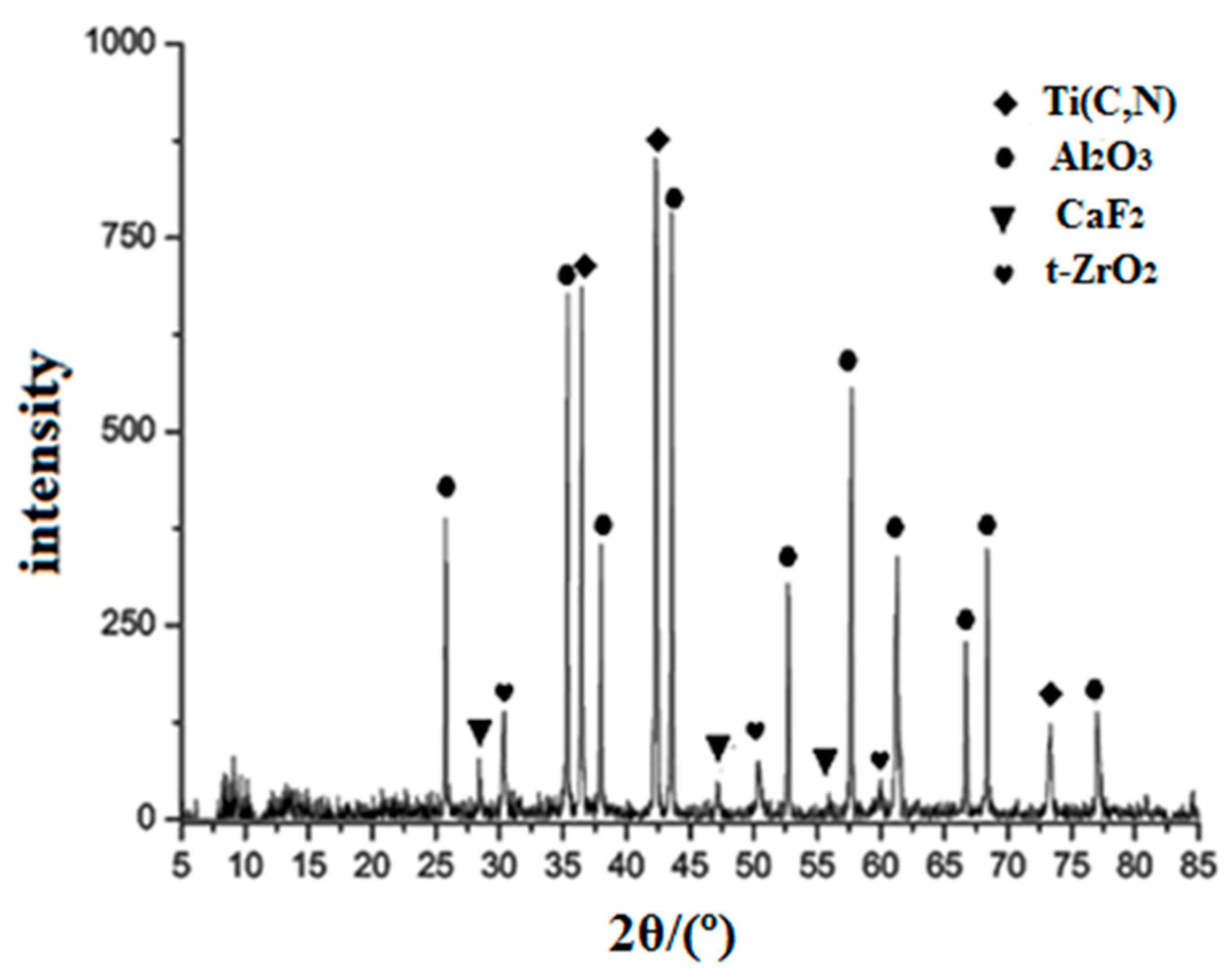
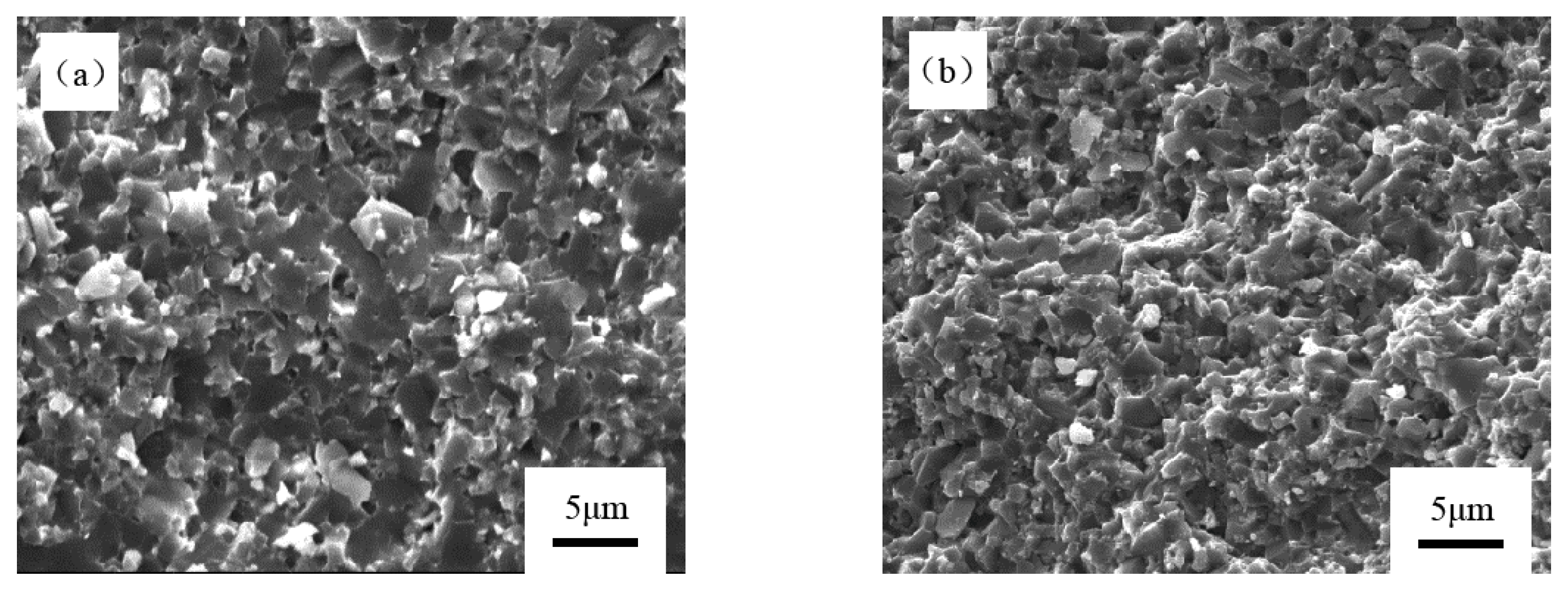
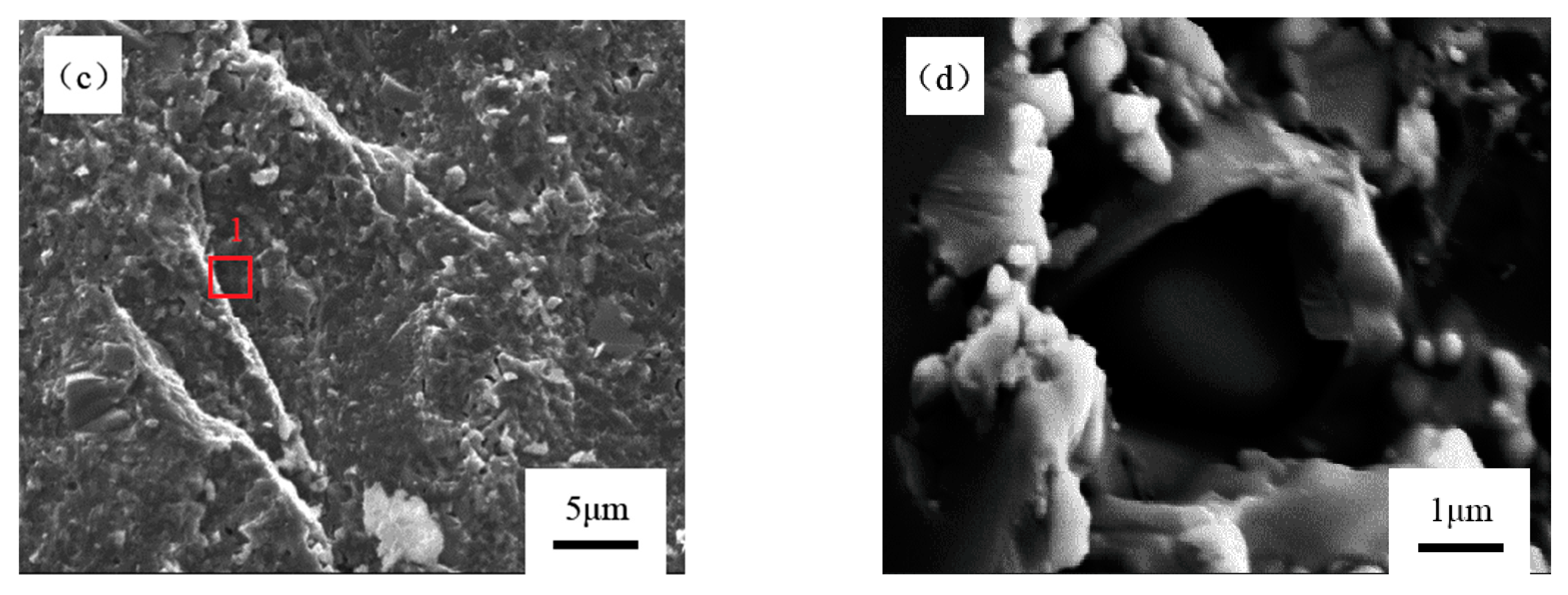
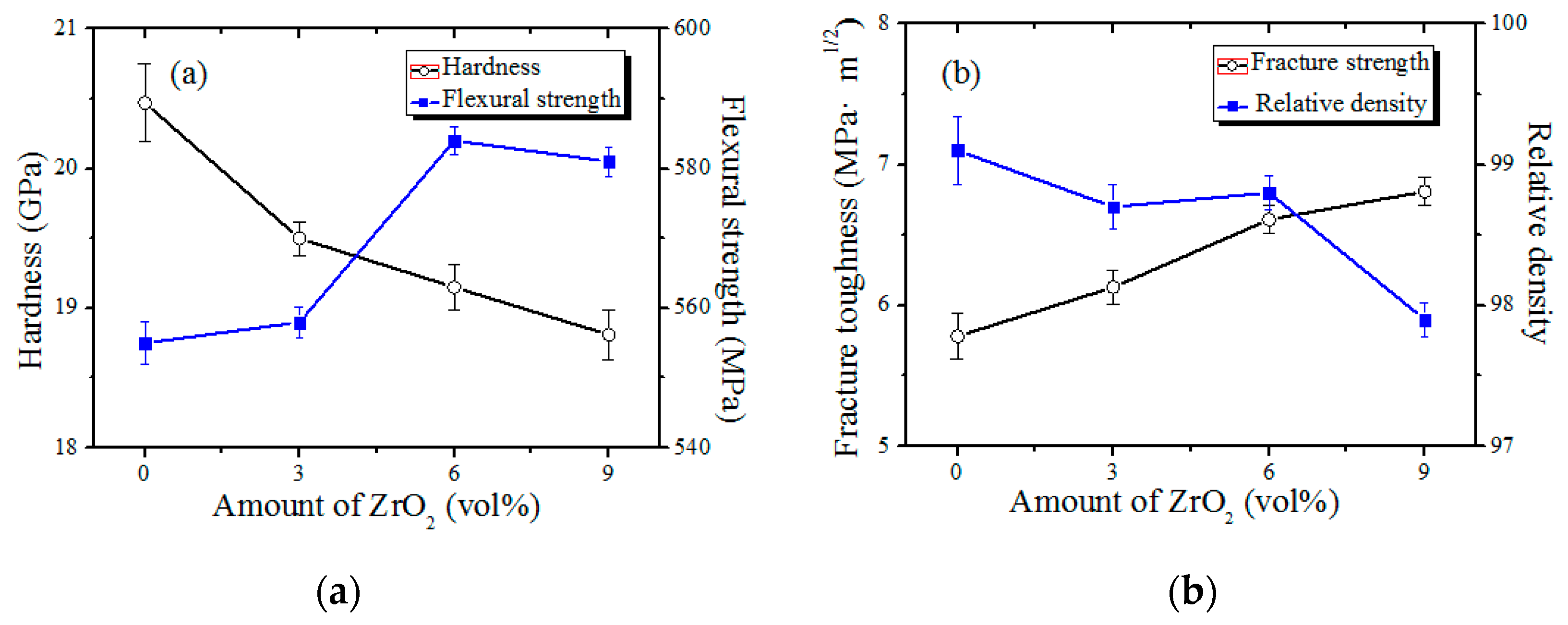


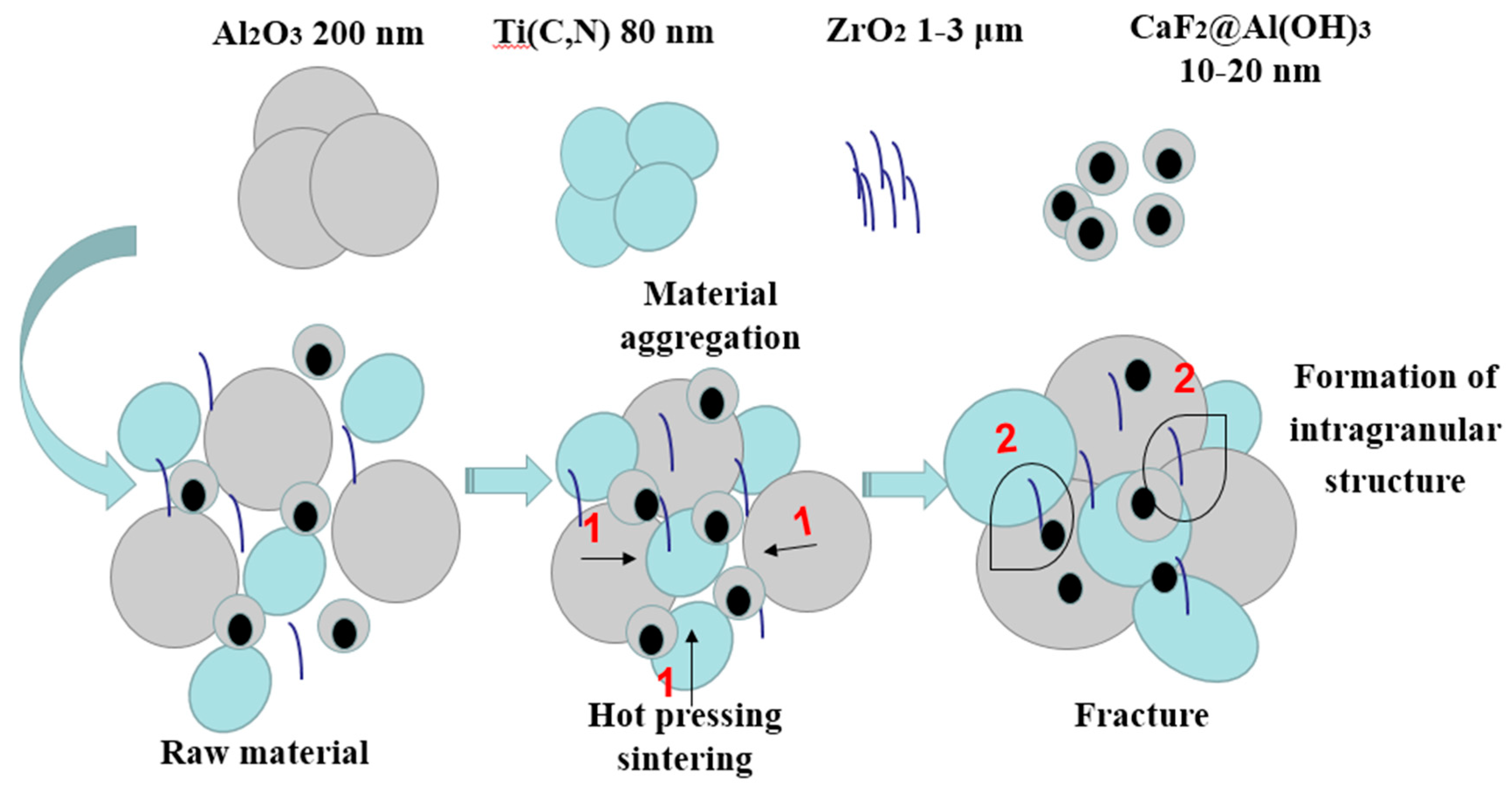
© 2020 by the authors. Licensee MDPI, Basel, Switzerland. This article is an open access article distributed under the terms and conditions of the Creative Commons Attribution (CC BY) license (http://creativecommons.org/licenses/by/4.0/).
Share and Cite
Li, Q.; Xiao, G.; Chen, Z.; Guo, R.; Yi, M.; Zhang, J.; Xu, C. Preparation and Performance of Al2O3/Ti(C,N)-Added ZrO2 Whisker and NanoCoated CaF2@Al(OH)3 Powder. Appl. Sci. 2020, 10, 4435. https://doi.org/10.3390/app10134435
Li Q, Xiao G, Chen Z, Guo R, Yi M, Zhang J, Xu C. Preparation and Performance of Al2O3/Ti(C,N)-Added ZrO2 Whisker and NanoCoated CaF2@Al(OH)3 Powder. Applied Sciences. 2020; 10(13):4435. https://doi.org/10.3390/app10134435
Chicago/Turabian StyleLi, Qi, Guangchun Xiao, Zhaoqiang Chen, Runxin Guo, Mingdong Yi, Jingjie Zhang, and Chonghai Xu. 2020. "Preparation and Performance of Al2O3/Ti(C,N)-Added ZrO2 Whisker and NanoCoated CaF2@Al(OH)3 Powder" Applied Sciences 10, no. 13: 4435. https://doi.org/10.3390/app10134435




